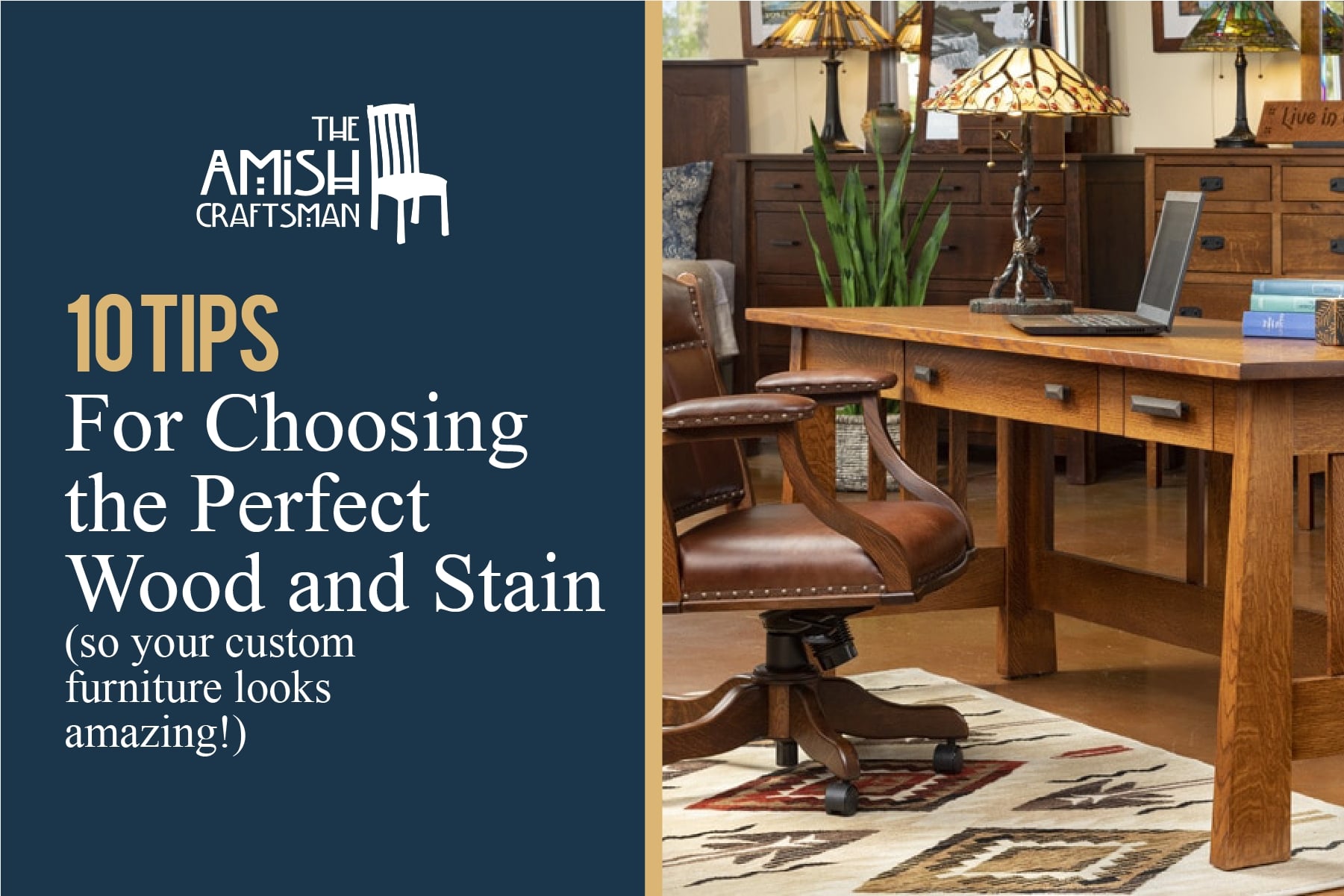Imagine running your hand over the silky smooth finish of a piece of furniture – lovingly crafted by human hands over many hours. It’s hard to take in the artistic, almost fragile designs unique to each piece,
If you stop and look – really look at the intricacies of the grains – the beauty is stunning.
Now imagine filling your home with this kind of exquisite furniture!
But don’t be fooled. Two beautiful pieces of furniture can look awful next to each other.
How can this be possible?
If the wood types and stain colors of the furniture in your home don’t complement each other, even the grandest pieces of furniture will look ugly.
Without a good understanding of wood and stain, you won’t be able to choose the elements needed to make the perfect piece of furniture for your home.
Here at The Amish Craftsman, we understand the struggle, and we are here to help.
In this article, we help you understand wood and stain so you can go to your local custom furniture store and order the ideal piece of furniture for your home.
Let’s get started!
Understanding Wood
Wood is the most commonly used material when it comes to building furniture. And it’s been that way for centuries.
But why?
Here are four reasons wood is considered a prime material for building furniture:

Why Wood is a Great Material For Building Furniture
Wood is an excellent material for building furniture for various reasons. Let’s explore a few of them:
1. Wood is strong and durable.
When it comes to quality furniture, wood is one of the strongest and most durable materials available. In fact, weight for weight, wood is one of the toughest materials we know of.
It makes a lot of sense that wood is strong if you think about it. Picture about a tall redwood tree. A tall tree like that has to be made of something pretty strong if it’s going to support its own weight and stay standing even when wild winds blow.
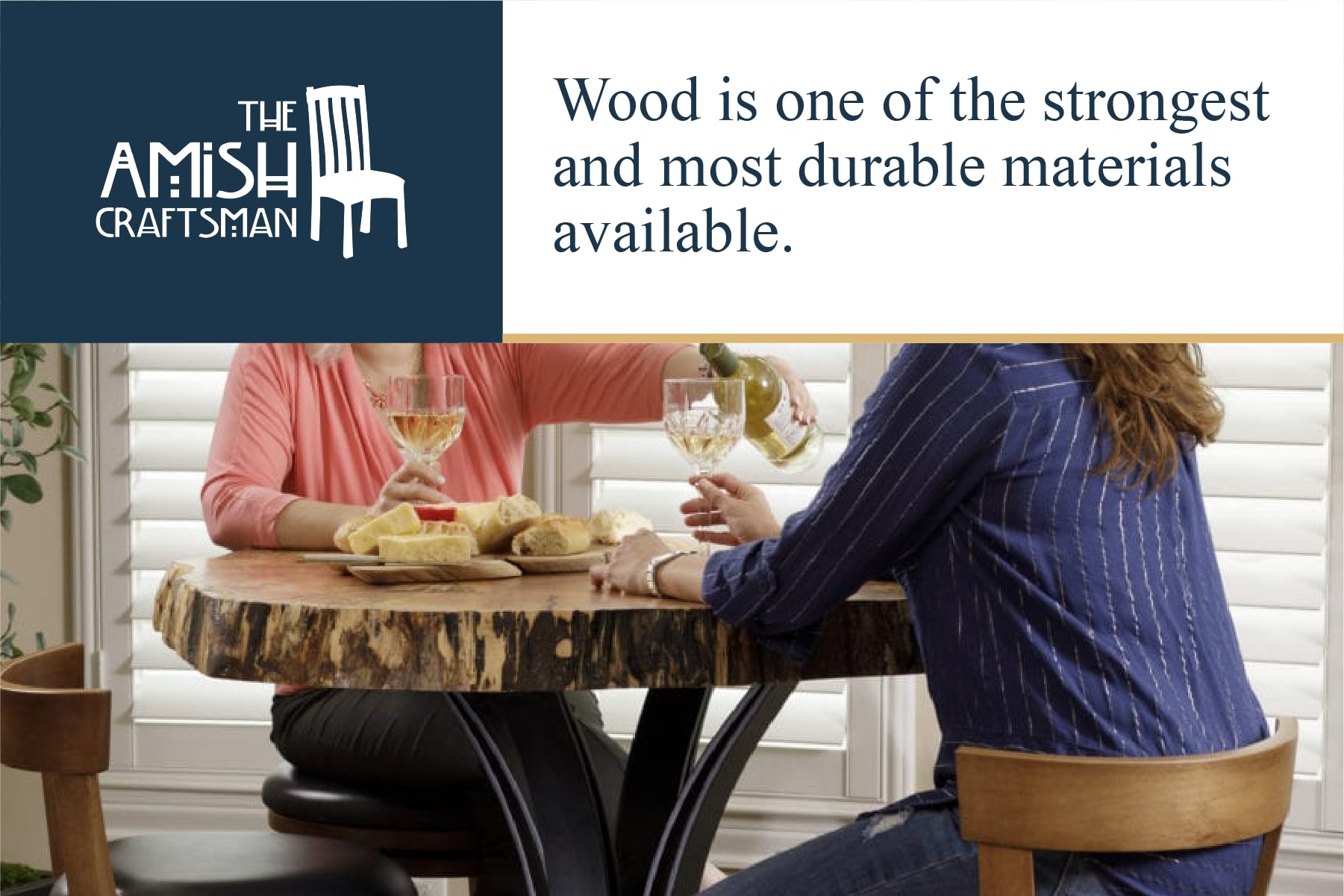
That kind of toughness means that wood beats almost every material when it comes to the longevity of furniture.
Since wood lasts a long time, you know that furniture built from wood will give you an excellent return on your investment. You can sell a piece of solidly made, well-maintained, wood furniture years after you bought it.
2. Wood looks amazing.
You could probably argue that some furniture materials are more durable than wood. But who wants a plastic rocking chair or kitchen table in their house?
Thankfully, wood isn’t just strong and durable – it’s also beautiful.
Whether it be light-colored wood or rich, dark hues, wood adds dignity and charm to any room. And when crafted by a skilled artisan, the potential for wood furniture to improve your home is endless!
As a bonus, wood furniture brings a bit of the outdoors inside your home. Since wood has a natural color and fascinating grains, it brings a sense of nature to otherwise sterile environments. It also adds warmth to any room.
3. Wood comes from a sustainable source
When wood is responsibly sourced and certified, it represents an excellent option for sustainability.

That means you can have a strong, beautiful piece of furniture, all while supporting the environment. It’s a win-win!
4. Wood comes in many varieties
Do you have a rustic decorating style? Perhaps you prefer a farmhouse, cottage, or modern look.
Whatever you prefer, there are hundreds of types of wood you can choose from, so your furniture fits your style. (For more information on designing a room to fit your style, check out our blog!)
Hardwood vs. Softwood
If you are going to make a good choice when it comes to the custom wood furniture in your home, you’ll need to know the difference between hardwood and softwood.
Hardwood is wood that comes from angiosperms – plants that produce seeds with some sort of covering. The covering could be in the form of a fruit or a hard shell.
Softwood comes from gymnosperms – trees whose seeds fall to the ground with no covering (like a pine cone).

Here’s another way to think about it: trees that lose their leaves during the winter are likely hardwood, while trees that keep their leaves year round are probably softwood.
If you would like to see a list of softwood and hardwood trees, read this article by Engineering Toolbox.
In general, hardwoods are denser, and therefore harder than softwoods – though this rule doesn’t always apply.

Hardwoods also contain pores, whereas softwoods don’t. These pores make the wood grain of hardwoods more prominent than the grain in softwoods.
The question remains: is softwood or hardwood better for building furniture?
You can use both types of wood to create beautiful furniture. But since hardwood is denser and contains more natural grain, it is most often the preference when it comes to flooring, decks, and high-quality wood furniture.
Softwoods are also very useful, though their most common application is in framing lumber, trim, and finish components for doors and windows.
Understanding Wood Stain
You’ve probably smelled the strong scent of wood stain on new furniture or in a wood shop, or maybe you’ve even applied a layer of the sticky substance to a DIY project at home.
Let’s take a look at what wood stain is, and why it’s important.
What is wood stain?
As the name suggests, a wood stain is a substance that changes or enhances the natural color of your wood.
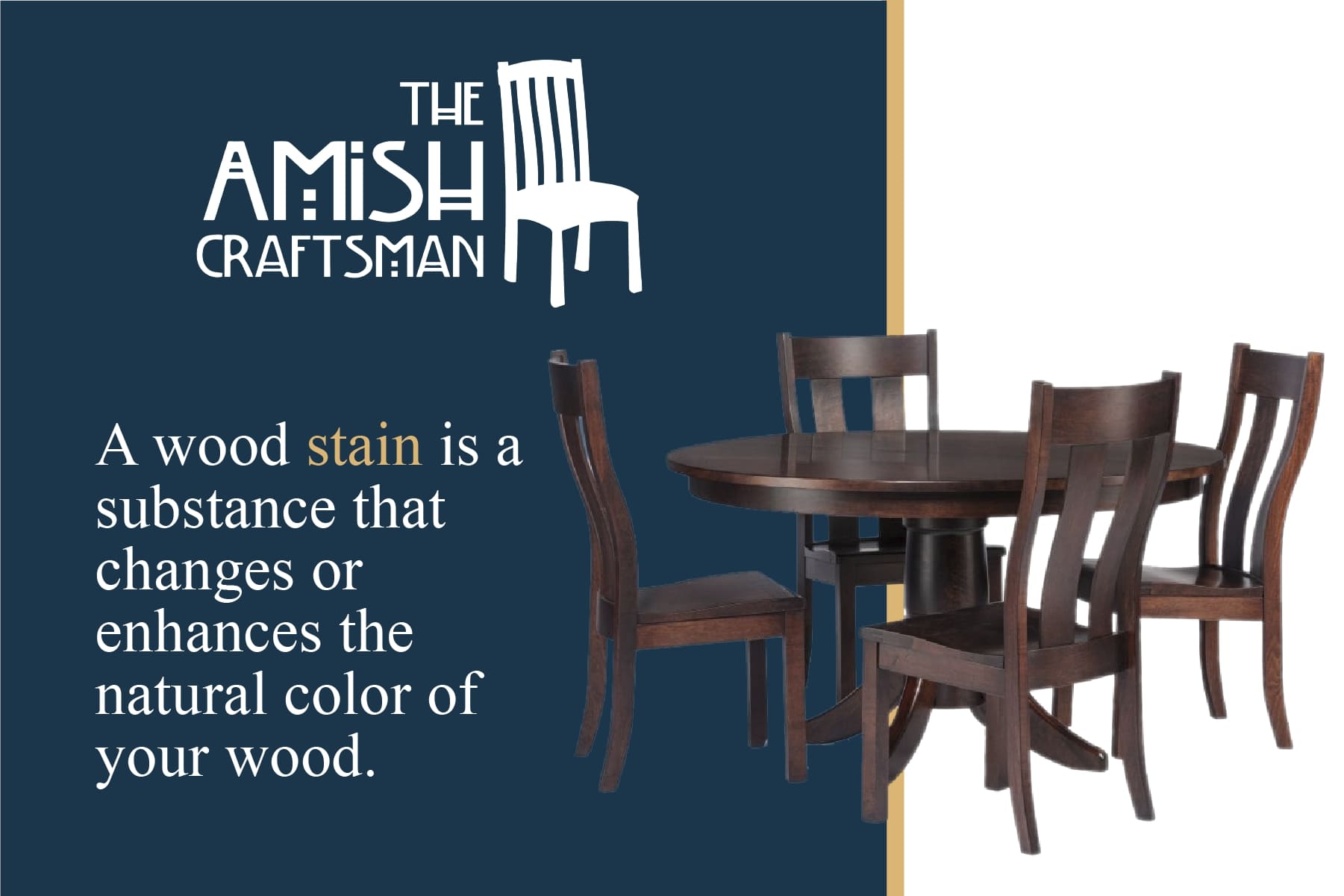
That sounds like paint, right?
Well, stain is quite similar to paint! It is composed of the same three primary ingredients: pigment, solvent, and binder.
However, stain contains less binder than paint, allowing the stain to penetrate the wood deeply and highlight the grain of the wood.
Wood stains do provide some protection from the elements, but their primary function is coloring the wood. If you have a piece of furniture that is exposed to the weather, you should make sure it has a protective varnish applied to it.
Why wood stain is important
But does wood stain even matter?
It sure does! Let’s look at some reasons why wood stain is essential.

1. Wood stain affects the aesthetics of your home.
Like we already mentioned, the primary purpose of wood stain is to color the wood in your home to your preference.
Just like paint, you can choose two wood stain colors that do not look good together!
Or, with some intentional planning, you can impress visitors with the design and purpose behind your living space.
Either way, the stain you choose makes a big difference in the aesthetics of your home.
2. Wood stain preserves the natural look of wood
The aesthetic appeal of wood lies in its natural look. When you paint wood, the grain becomes nearly invisible and the wood’s natural beauty doesn’t show.
That’s why wood stain is almost always preferred over paint when it comes to high-quality furniture. Wood stains can even be untinted and uncolored so that your furniture has an entirely natural appearance.
3. Wood stain increases the longevity of furniture
Just because your furniture is indoors doesn’t mean that you shouldn’t protect it.
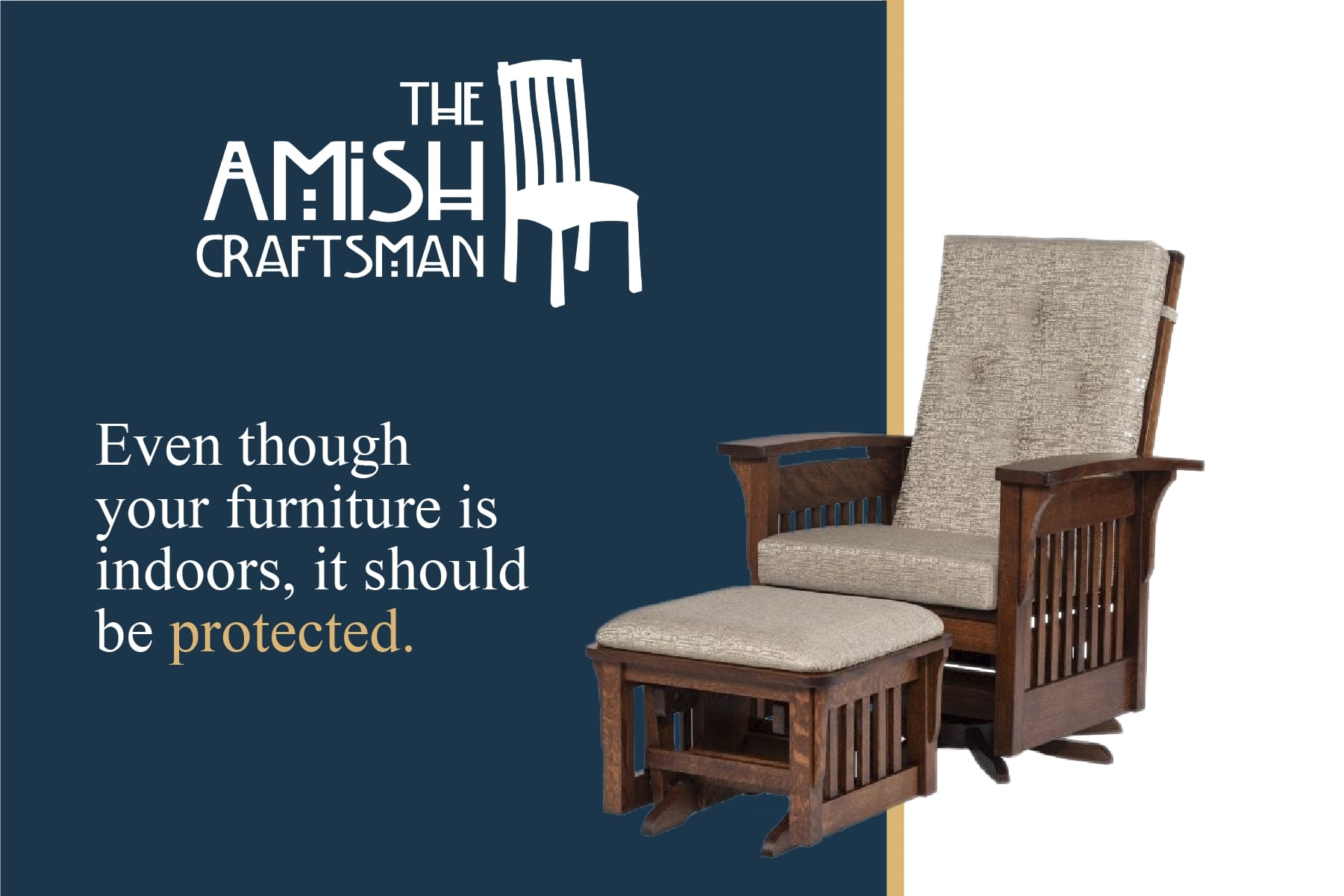
For example, a water spill on raw wood that is not cleaned up can soak into the wood and begin to rot the wood.
Even worse is when you spill a substance that stains (like wine) on raw wood. Without stain and varnish, such substances mar the wood and you’ll be left with an unsightly stain on your furniture. That is why a layer of finish is especially important on pieces such as dining tables.
Sunlight can also cause damage to unsealed wood, resulting in unsightly discoloration.
Sealing wood with stain will preserve the appearance and structural integrity of your wood.
5 Tips For Choosing The Right Stain For Your Furniture
Ok, so we know that choosing the right wood and stain matters.
Here’s the problem:
That knowledge only adds to our stress if we don’t know how to choose the right wood and stain for furniture!
So, let’s get down to business and talk about how you can confidently choose the right stain color for your custom furniture.
Tip #1: Complement – Don’t Match!
Here’s a common mistake that lots of people make:
They try to precisely match new furniture to an existing color in their house.
It sounds like a great idea, but it rarely works. The result is painful – it looks like you tried to match and missed it by just a bit (which, of course, is true!)
Instead of trying to match your flooring, cabinets, or any other object in the house, focus on complementing the particular colors of a room.

You’ll be rewarded with a stunning look that is clearly intentional and well designed.
But it gets better:
When you mix and match wood stains within a room, the area gains visual interest. As long as the different stain colors are complementary, they give your home a lived-in, relaxed feel.
Tip #2: Observe the Wood Undertones
Our first tip is one of the most important when it comes to choosing the right wood stain. But what if you aren’t confident that you can choose wood stains that complement each other?
We suggest you look closely at the undertones of the furniture already in your home. Determine whether the undertone is cool or warm and attempt to match the undertone.
For example:
Let’s say you have a laminate wood floor in your living room. The undertone of the wood is a rich, medium brown color though the floor is primarily characterized by the dark brown and black streaks running through it.
You could choose a stain color based on the medium brown color seen in the undertone of the floor. The result would be a piece of furniture that complements the floor but doesn’t match it.
Tip #3: Look at Things From a Distance – Not Side-By-Side
Most people grab a scrap of flooring or some other piece of wood furniture in their house when they head to their local custom furniture shop.
This isn’t a terrible idea. After all, having a physical piece of wood to compare to the furniture you want to buy allows you to compare colors and undertones.
Just remember to take a few steps back when you are sizing things up.
Sometimes colors, hues, and undertones look different from a distance than they do close up.

And once you get a new piece of furniture in your home, you’ll spend most of the time looking at it from a distance, not inspecting it from a few inches away!
Tip #4: Be Aware of the Lighting in Your Room
Just like distance, the lighting of a room makes a difference in how things look.
In other words:
A piece of wood furniture might look different in the lighting of your home than it does sitting in a showroom.
This is the reason we do house calls at The Amish Craftsman. We can bring wood and stain samples into your space so you can see what they look like in real-time light.
Tip #5: Avoid Trends
Trends are such sticky things.
We fall into them, almost without knowing it. Then one day we wake up wondering why we chose such horrendously ugly clothes or why we thought that hairstyle looked cool.
Chances are, we were following a temporary trend.
Personal grooming isn’t too difficult to change, but you don’t want to buy a new bedroom set based on trendy colors – especially if you invested in high-quality, wood furniture!
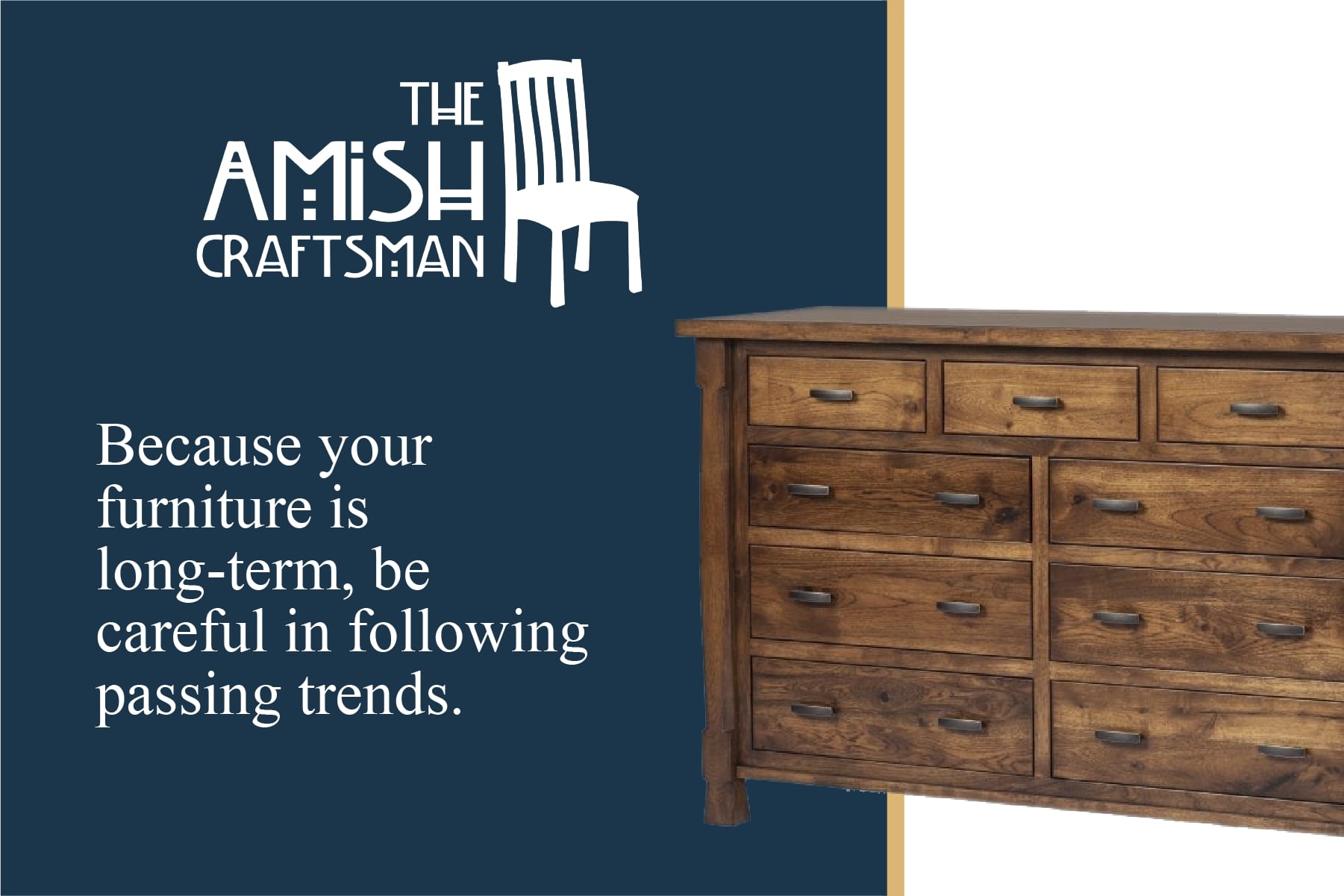
What you need to do is sit down and have a heart-to-heart conversation with yourself.
It doesn’t matter what your friend just put in their house. It doesn’t matter what you see splattered across your social media feed.
What do you like? And not just, what do you like right now, but what will you still like in 20 years? (Usually classic, traditional looks are the ones that you will enjoy for years).
Discovering your personal style can be challenging – especially when your “style” is influenced by trends. But stick at it. Choose the woods and colors that you love, and you’ll be happy for a long time!
(By the way, if you are looking for tips on design or style, check out some of our other blogs!)
- Styling and Designing With Rustic Furniture
- 8 Keys to Design Your Perfect Living Room Layout
- 5 Secrets to Design a Room That is Stylish and Fun!
- How To Make A Rug Work In Every Room In Your House
5 Tips For Choosing The Right Wood For Your Furniture
Alright, we’ve made some progress on choosing a good stain for furniture. Now, let’s get down to business on selecting the right wood for new furniture.
Tip #1: Consider the Use of the Piece
The type of wood you choose to construct your furniture depends mainly on how you will use the furniture.

Are you looking for an everyday dining room table? If so, you should choose a hardwood that doesn’t get dinged or scratched easily. Hickory or quarter sawn white oak are both excellent examples of this type of wood.
But if you want a new bed frame, a softer wood like cherry would work great.
But what if you don’t know how hard or soft a particular type of wood is? Should you cross your fingers and hope you choose the right kind of wood?
Nope! You need to consult the Janka Hardness Scale.
The Janka Hardness Scale determines how hard a particular type of wood is. The scale was invented by an Austrian wood researcher named Gabriel Janka and was standardized in 1927 by the American Society for Testing and Materials.
The test is simple:
Drop a steel ball on a piece of wood and figure out how many pounds per square of force is needed to push the ball halfway into the plank.
The higher the number on the Janka Scale, the harder the wood is!
But don’t panic. You don’t need to have a steel ball and a whole lot of physics skills to figure this out every time you go to the furniture store. You just need to consult the scale.
Tip #2: Check Out the Price of the Wood
This one might seem like a no-brainer. You should check the price of ANY product before buying it.
However, with wood, price checking is particularly significant.
Why?
Because the price of wood is not directly related to the quality of wood. Rather, wood prices are primarily affected by how readily available a wood species is.

In other words, you could pay more money for a wood product that is inferior to a product that costs less.
Tip #3: Where Does the Wood Come From?
We want your home to look great – and we’re ready to do everything we can to help you achieve that goal.
But please, avoid the use of rare exotic woods that are illegally clear-cut from the world’s rapidly disappearing rainforest.
We have destroyed half the world’s rainforests in a century, and at this rate, you could see them vanish altogether in your lifetime.
If that doesn’t worry you, consider the fact that deforestation is considered the second most important driver of climate change – responsible for 18-25% of global annual carbon dioxide emissions.
At The Amish Craftsman, we care about future generations, so we make sure all of our wood is sustainable and legally cut.
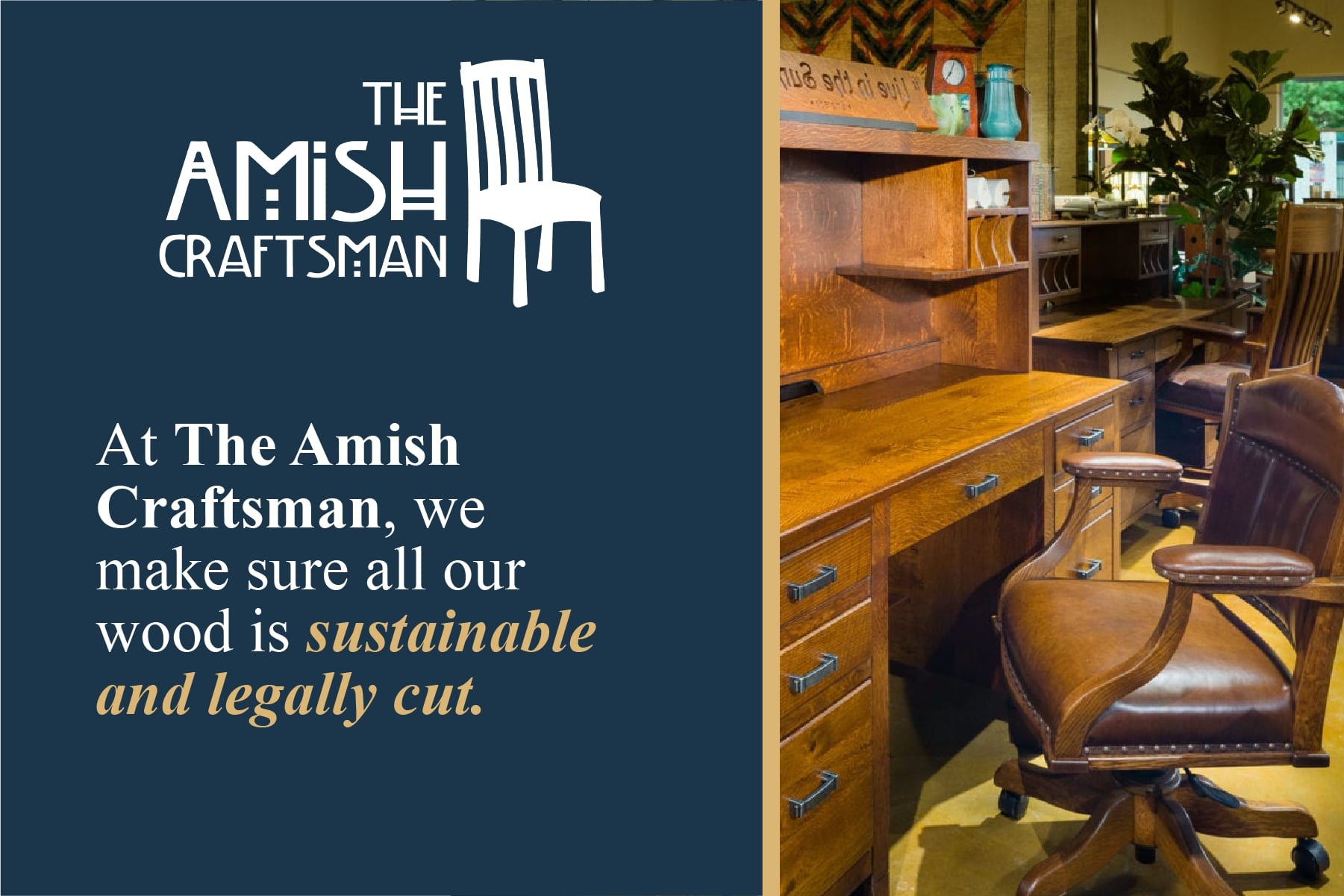
Tip #4: How “Wild” Do You Want to Be?
The grain in different types of wood can fluctuate a lot.
In general, you can find six types of wood grain:
- Straight grain: the grain runs roughly parallel with each other
- Irregular grain: the grain runs at varying and erratic directions (like wood grain around knots)
- Diagonal grain: a grain that results when a straight-grained log isn’t sawn along its vertical axis
- Spiral grain: a tree that somehow grew twisted produces spiral grain where the wood fibers follow a spiral course.
- Interlocked grain: comes from trees whose fibers in each growth layer tended to align in opposite directions
- Wavy grain: the direction of the wood fibers constantly changes in a wave pattern
Different wood grains don’t show up consistently in particular types of wood. In fact, some specialty wood grain patterns come from the way the wood is sawn, not from the natural tree.
Tip #5: Remember – Wood May Change Color Over Time
It’s always good to remember that many kinds of wood change color over time.
For example, cherry wood darkens into a beautiful, reddish wood overtime.
Maple, on the other hand, may begin to slightly yellow over time.
If you’re worried about the future color of your wood furniture, consult a custom furniture shop or sawmill near you. They can give you sound advice on how your wood will age over time.
Conclusion
We’ve come a long way! You now know why choosing the right wood and stain is essential, and beyond that, you have some tools to choose the right kind of wood and stain.
But, now we want to make it even easier for you.
If you are looking for a new piece of custom furniture, but aren’t sure exactly what you need in wood and stain type, just contact us at The Amish Craftsman.
We’d love to have you visit our store for inspiration, and we’re more than willing to help you make a good choice about the perfect piece of furniture for you.
We have more than furniture, too! We also carry:
- Arts and Crafts Rugs
- Craftsman Rugs
- Lighting
- Home Decor
- And furniture for every room in your home!
Our furniture is made in America and built to last a lifetime. But best of all, it is custom built – designed precisely for your style and to fit your space.
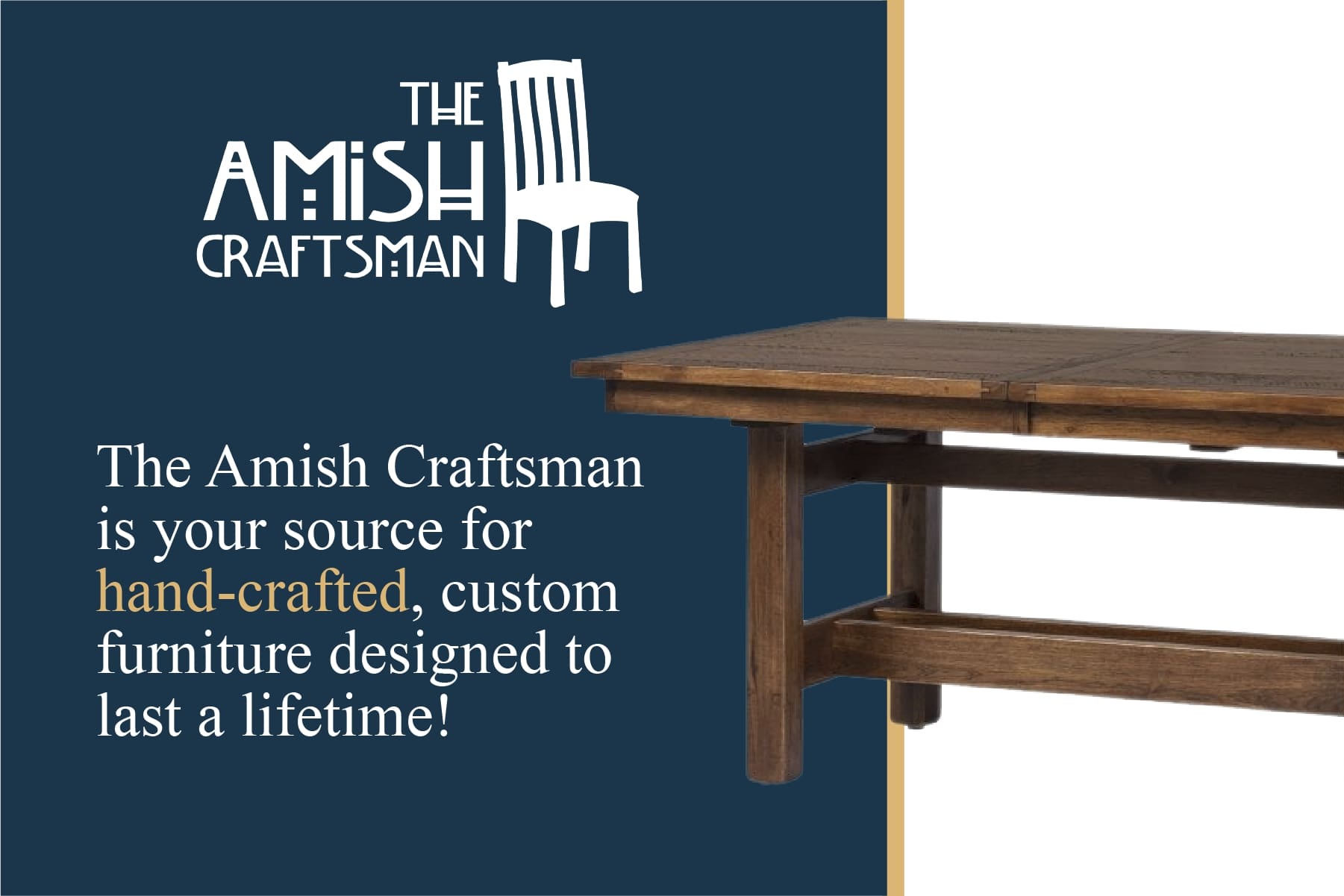
In 2020 we were voted the “Best of the Best Furniture in Houston” by the Houston Chronicle, and we can’t wait to serve you with our very best.
Contact us today! We look forward to hearing from you!

